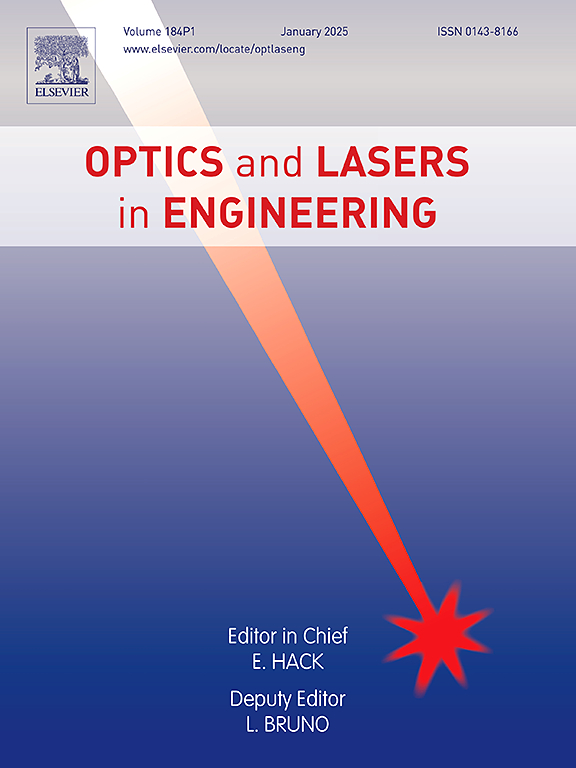Magneto-optical imaging detection and classification of weld defects under alternating/rotating magnetic field excitation
IF 3.7
2区 工程技术
Q2 OPTICS
引用次数: 0
Abstract
Aiming at the difficult to detect arbitrary-angle weld defects, a magneto-optical (MO) imaging non-destructive testing (NDT) system for weld defects excited by different magnetic fields is studied. The mechanism of the alternating magnetic field generated by the U-shaped yoke and the rotating magnetic field produced by the plane cross yoke is introduced, the magnetic field distribution of weld defects is analyzed by using finite element simulation. The MO imaging effects of different weld defects excited by alternating/rotating magnetic field are compared. The relationship between imaging characteristics of MO images and magnetic field strength is analyzed based on the Faraday rotation effect. The gray value of MO image can match the corresponding leakage magnetic field strength. MO imaging NDT experiments are performed on weld defects, including non-penetration, pit, surface crack, and subsurface crack. The principal component analysis (PCA) method is used to extract the grayscale features of the fused image column pixels and the texture features of the MO image are extracted by the gray-level co-occurrence matrix (GLCM). A BP-AdaBoost neural network model and a support vector machine (SVM) model are established to identify these defect features. Experimental results show that the classification accuracy of the BP-AdaBoost neural network model and the SVM model can reach 98.2 % and 98.6 % respectively under the excitation of rotating magnetic field. Compared with the alternating magnetic field, the classification accuracy is improved by 7.5 % and 8.5 %, respectively. MO imaging under rotating magnetic field excitation overcomes the limitation of directional detection of MO imaging under traditional magnetic field excitation, and realizes the detection and classification of arbitrary-angle weld defects.
交变/旋转磁场激励下焊接缺陷的磁光成像检测与分类
针对难以检测任意角度焊接缺陷的问题,研究了一种针对不同磁场激发的焊接缺陷的磁光(MO)成像无损检测(NDT)系统。介绍了 U 形磁轭产生的交变磁场和平面十字磁轭产生的旋转磁场的机理,并使用有限元模拟分析了焊接缺陷的磁场分布。比较了交变/旋转磁场激发的不同焊接缺陷的 MO 成像效果。基于法拉第旋转效应,分析了 MO 图像的成像特征与磁场强度之间的关系。MO 图像的灰度值可与相应的泄漏磁场强度相匹配。对焊接缺陷进行了 MO 成像无损检测实验,包括非穿透、凹坑、表面裂纹和地下裂纹。采用主成分分析(PCA)方法提取融合图像列像素的灰度特征,并通过灰度级共现矩阵(GLCM)提取 MO 图像的纹理特征。建立 BP-AdaBoost 神经网络模型和支持向量机 (SVM) 模型来识别这些缺陷特征。实验结果表明,在旋转磁场的激励下,BP-AdaBoost 神经网络模型和 SVM 模型的分类准确率分别可达 98.2% 和 98.6%。与交变磁场相比,分类准确率分别提高了 7.5 % 和 8.5 %。旋转磁场激励下的 MO 成像克服了传统磁场激励下 MO 成像定向检测的局限性,实现了任意角度焊接缺陷的检测和分类。
本文章由计算机程序翻译,如有差异,请以英文原文为准。
求助全文
约1分钟内获得全文
求助全文
来源期刊

Optics and Lasers in Engineering
工程技术-光学
CiteScore
8.90
自引率
8.70%
发文量
384
审稿时长
42 days
期刊介绍:
Optics and Lasers in Engineering aims at providing an international forum for the interchange of information on the development of optical techniques and laser technology in engineering. Emphasis is placed on contributions targeted at the practical use of methods and devices, the development and enhancement of solutions and new theoretical concepts for experimental methods.
Optics and Lasers in Engineering reflects the main areas in which optical methods are being used and developed for an engineering environment. Manuscripts should offer clear evidence of novelty and significance. Papers focusing on parameter optimization or computational issues are not suitable. Similarly, papers focussed on an application rather than the optical method fall outside the journal''s scope. The scope of the journal is defined to include the following:
-Optical Metrology-
Optical Methods for 3D visualization and virtual engineering-
Optical Techniques for Microsystems-
Imaging, Microscopy and Adaptive Optics-
Computational Imaging-
Laser methods in manufacturing-
Integrated optical and photonic sensors-
Optics and Photonics in Life Science-
Hyperspectral and spectroscopic methods-
Infrared and Terahertz techniques
 求助内容:
求助内容: 应助结果提醒方式:
应助结果提醒方式:


